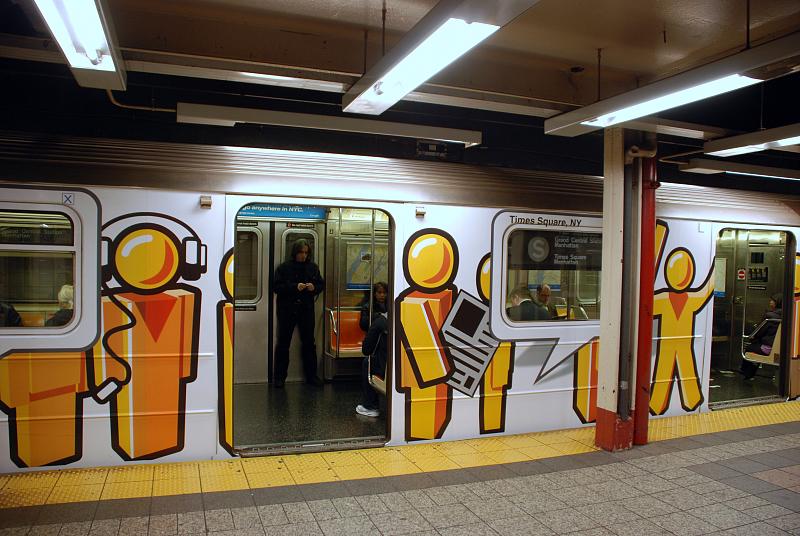A Shuttle train sits at Grand Central, decked out in Google Maps advertising. (Photo by flickr user Paolo Mastrangelo)
Around the country, advertising revenues are dropping precipitously. From traditional bastions of print media to online news outlets, any business dependent upon advertising is feeling the crunch. The MTA is no exception.
As revenue goes, advertising isn’t really a key source of money for transit systems. In total, according to the Federal Transit Administration numbers, transit agencies drew in $334 million in revenue in 2007. That total makes up around one percent of nationwide transit revenue. Closer to home, the MTA reported over $100 million in revenue in each of the last two years.
Not this year, says William Neuman. According to The Times scribe, the agency is seeing lower-than-projected revenue from advertising due to missed minimum payments by Titan Worldwide. The advertising agency is tasked with selling ad space on buses and subways and in stations and owes the MTA around $7.5 million for a three-month period ending in April. Neuman reports:
The company, Titan Worldwide, fell short a total of $7.5 million in mandatory payments to the Metropolitan Transportation Authority from February through April, citing lower than expected ad sales. That would be enough to buy 16 new buses for the authority, which recently received a state bailout in the face of multibillion-dollar budget deficits over the next few years.
“This is another example of the M.T.A.’s exposure to the global economic recession,” said Aaron Donovan, a spokesman for the authority, which plans to raise fares and tolls by about 10 percent in June…
Another company, CBS Outdoor, sells ads in the subway system, and it fulfilled its contractual requirement of making a $55 million lump-sum payment to the authority in January for all of 2009.
Neuman’s article is chock full of interesting information about subway and bus advertising. For example, an ad on the outside of a Manhattan-based bus sells for $1500 a month this year. In 2008, the MTA could command $1800 for the same ad.
On the business side, overall sales for CBS Outdoors, another MTA advertising partner, are strong due to the new ad spots on the outside of train cars. Titan, on the other hand, still owes the agency money from last year, and the agency may have to renegotiate its deal with the MTA to avoid incurring crippling penalties and payments.
“We’re trying to work with them to find a way to keep this contract in place,” Donovan said to The Times. “Our goal is to work it out and minimize the impact on the M.T.A.’s bottom line.”
Neuman also notes that Titan’s original bid for the 10-year contract with the MTA was for $103 million more in minimum guaranteed payments than the next highest bidder. William Apfelbaum, the company’s chairman, said that the difference in minimum payments would not impact his company were the economy strong.
In the end, the MTA isn’t really relying on advertising revenue for a significant portion of its budget, but the story remains the same: A public transportation agency should not have to attempt to squeeze every last dollar out of advertising just to stay afloat. We applaud the MTA for looking at new ways to draw in revenue through advertising, but as long as that money is icing on the cake and not a key part to the budget, we would have nothing to fear.


3 comments
Titan was the one who was put in charge of the localized digital bus ads right?
Yes it is.
Are the digital bus ads running in buses now? I remember hearing they were an expensive investment.